MARY OF THE INCARNATION
MYSTIC AND MISSIONARY: SAINT MARY OF THE INCARNATION (1599-1672)
(adapted from “Elements of Ursuline History and Spirituality” by Sr Marie Bénédicte Rio osu)
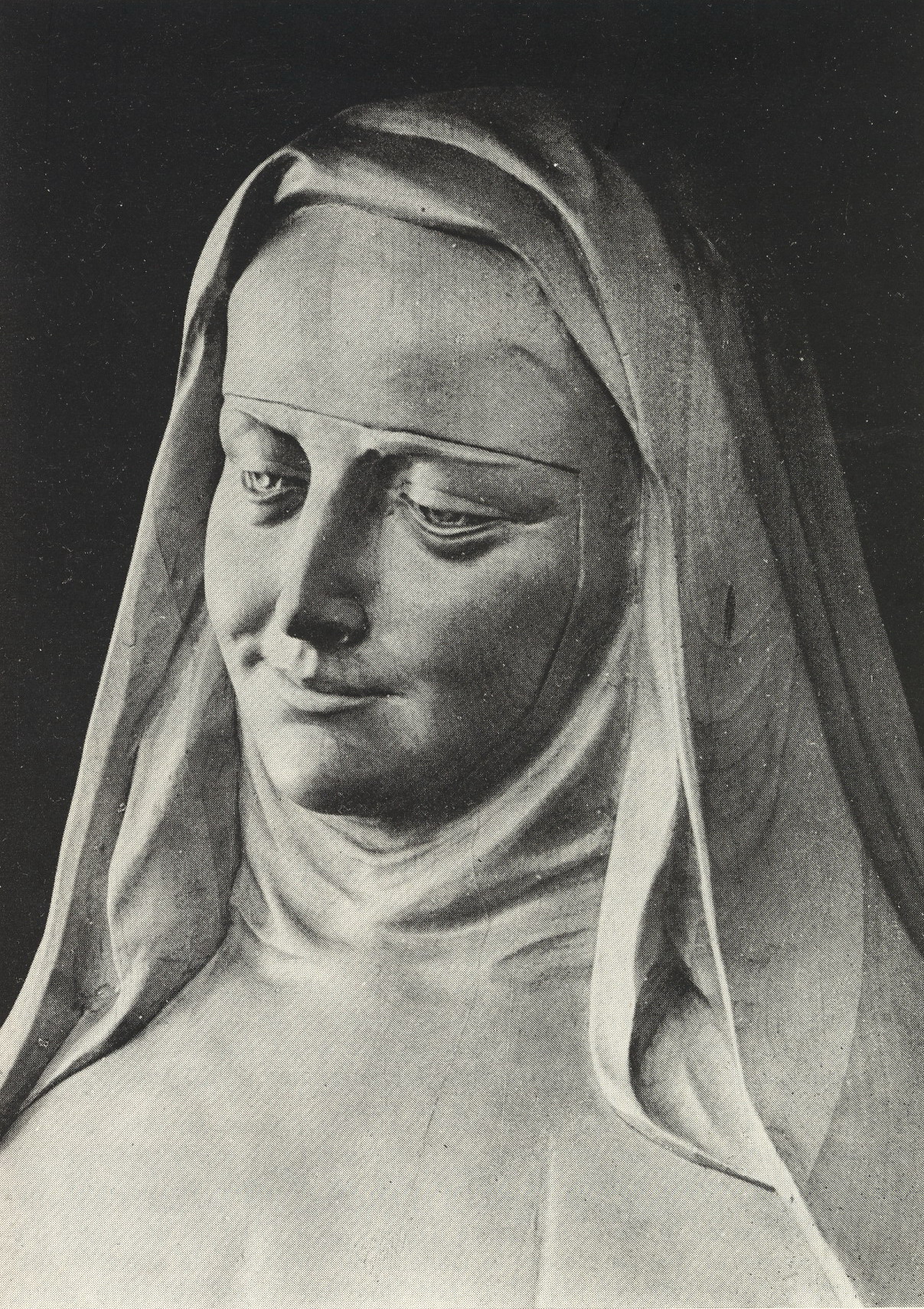
CHILDHOOD
On 29 October 1599, the bells of the church of Saint-Saturnin in Tours rang for the baptism of a little girl born on the previous day. Marie Guyart was the fourth child of a family of eight. Florent Guyart, a master baker, and his wife, Jeanne Michelet, were people of solid faith and piety. The little girl grew, in the midst of a united household, lively, sensitive, smiling. Gifted with an excellent memory and ease of speech, she charmed the whole house when she repeated, not without humour, the sermons heard in church.Little did anyone think, among her circle of family and friends, that she would become one of the great mystics of the 17th century which was to produce so many, and the first woman missionary.
Everything began with a dream... Marie was seven years old.
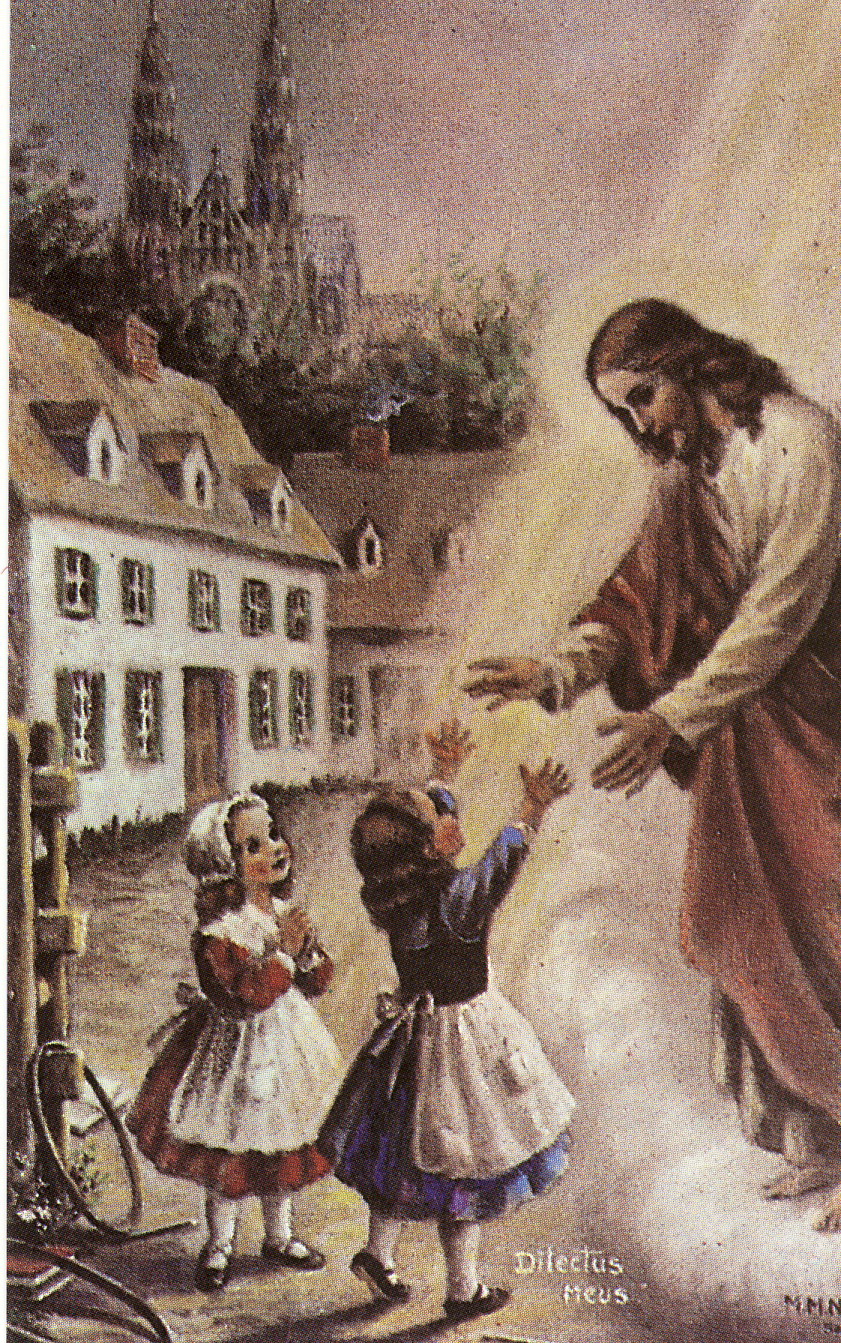
- Lifting my eyes toward the sky I saw the heavens open and Our Lord Jesus Christ, in human form, came toward me through the air; seeing Him, I cried out to my companion: "Look! It is Our Lord! He is coming toward me!" - And it seemed to me that as this little girl had committed a fault, he had chosen me rather than her even though she was a good girl. But there was a secret which I did not understand (...) I began to hold out my arms to embrace Him, and He, the most beautiful of the sons of men, with a look full of sweetness and inexpressible attractiveness, embraced me and kissed me with indescribable love and asked me: “Will you be mine?” - I answered him: "Yes". Then, when he heard my consent, we saw him go back into the sky"
(J II, 160 Sullivan p.3-4)
It was only a dream, but the child was marked by it for life. Her "bent for good" and her desire for God increased, thereby putting into concrete form the "yes" pronounced in her sleep, a "yes" which was already a "yes" of betrothal. She chose Christ for her "captain" and even then she dreamt of foreign countries where she could "proclaim the Word of God" (cf. J II, 171).
It was not surprising that, towards her fifteenth year, she gave thought to religious life. But when she spoke about it to her mother, the latter judged her daughter to be of too lively a disposition for the convent! The Guyarts, moreover, like all the parents of that time, were already looking for a husband for her. They found one in the person of a master silk merchant - young or old, we do not know. And Marie, docile, "allowing herself to be guided blindly by her parents" as by Providence, married Claude Martin in 1617. She said this "yes" out of obedience. During her two years of married life, she must often have repeated it in one way or the other.
WIFE AND MOTHER
"Mademoiselle Martin" worked as an embroiderer in her husband's workshop, but this did not prevent her in any way from being the mistress of the house. She saw herself, at the age of 17, in charge of a household grouping together all those working in the shop and their families. It was far from easy! Life was still further complicated by the fact that her mother-in-law, probably disappointed that she was no longer the "first", made her feel it; and also by the fact that there was another woman - jealousy? ambition? - who was the cause of many trials for Marie (cf. 0V, 36-37). She was so discreet on the subject that it is impossible to know the exact nature of these trials. One thing is certain, though, namely that in 1619 the workshop was on the verge of bankruptcy, and that poor Claude Martin seemed powerless to stop it.One joy in the midst of her worries was the birth of little Claude on 2 April 1619. But six months later, young Madame Martin was a widow.
THE VISION OF BLOOD - CONVERSION
She was twenty, with a baby in the cradle and left with all the difficulties of liquidation on her hands. But she had on her side the strength given her by prayer, her balanced temperament and her "head for business". It was during this period of worries, on 24 March 1620, that the Lord revealed himself to her again, in a striking manner.- One morning, I was going about my affairs and was repeating the ejaculation which had become my ordinary prayer: “In Thee, 0 Lord, do I trust, let me never be confounded” when I was suddenly brought to a halt, interiorly and exteriorly... Then at that moment, the eyes of my soul were opened and all my faults, my sins and imperfections which I had committed since my birth, were presented to me totally and in detail, with a clarity and a reality more certain than any human certainty. At the same moment, I saw myself plunged into a torrent of blood, and my spirit was convinced that this was the blood of the Son of God, the shedding of which I was guilty because of all the sins which had just been shown to me, and that this Blood had been poured out for my salvation.
(J II, 181-183 Sullivan p.13)
When Marie recovered, she found herself in front of the chapel of the Feuillant Fathers. She entered hoping to make her confession, but she was told to come back the following day. It was then that she would meet the priest who was to become her first director.
Following this event, which she would always refer to as her "conversion", Marie returned home, "changed into another creature". Her family urged her to remarry, which seemed simply common sense. But she hesitated. That kind of life was over, she was sure. She repeated her "Yes" to the One who had attracted her from her childhood; she made a vow of perpetual chastity, liquidated the workshop and returned to live with her father. Working to bring up her son, doing great penances, she deepened her prayer and solitude with God.
CAUGHT UP IN BUSINESS AFFAIRS.
Marie only enjoyed this solitude for a year, because her sister and brother-in-law asked her to come and help them. Paul Buisson was at the head of a transport business which was developing rapidly and becoming increasingly important. There was enough work there for a young widow. Marie was very tempted to refuse, but her director advised to accept. Could she not say "yes"?She thus found herself in 1621 employed by the Buissons. A servant like the others, in charge of the household, the kitchen and every sort of material work - the Spirit "inspired her to hide her natural talents" (cf. V, 41). In truth, she was not a servant at all like the others: within, she led a life of intimate union with her Lord; she made herself the catechist of the other employees, and also their infirmarian and conscience. She assumed over them an unusual moral influence; she made such an impact that Paul Buisson ended by noticing it. And when, in 1624, Madame Buisson had the hope of becoming a mother for the first time after fifteen years of married life, Paul, fearing for his wife's health, sent her into the country and entrusted the direction of his enterprise to his sister-in-law. (Little Paul was born in June 1624 but died shortly afterwards. Marie Buisson would be born in December 1626.)
After 1624, Marie therefore lived the whole time in the Buissons' house. She was now to experience harassing days and nights, untold worries, very heavy responsibilities for her young shoulders. None of this distracted her from God. On the contrary, she went through an extraordinary mystical experience:
- I spent almost the whole day in a stable that served as a warehouse, and sometimes at midnight I was still in the harbour supervising the loading and unloading of merchandise. My ordinary companions were dockers, carters, and even fifty or sixty horses that were entrusted to me (...) And yet, all these worries failed to turn me from God. On the contrary, I felt strengthened, since it was all for the sake of charity, and not for my own profit. At times, I found myself so burdened with work I did not know where to start. I would then turn to my usual refuge saying to Him: "My Love, I cannot do all that, do it for me, otherwise it will all stay here!" (...) All my austerities in no way weighed down my body; I put on a good face in the company I found round me, and people thought I was enjoying myself; but it was the union I had with God which made me so happy and light-hearted, as there was nothing in the world to give me pleasure.
(V, 55-56; J II, 162-163)
And again:
- [Our Lord] made me run in his ways, in the midst of the roughest material things which, while occupying my body, left my mind continually bound to the adorable Word Incarnate. If the clock chimed, I was obliged to count the hours on my fingers, for this interval of counting, though necessary, interrupted my loving conversation with my Well-Beloved. If I had to speak to a neighbour, my gaze never left my loved One; while my neighbour was answering, my conversation would resume, and my attention to what was necessary in no way distracted me from the attention I was paying to God. It was the same in my writings, in which my attention was twofold: to my divine Object and to the matter in hand. When I had to dip my pen in the ink, the time was precious, for mind and heart profited from it to converse with Him. Finally, even if everyone was present, nothing was able to distract me.
(J II, 231 Sullivan p.41)
This "deep attentiveness to God" did not prevent Marie from going through periods of painful darkness which alternated with graces of intense light. At the beginning of 1625, she saw her heart enclosed in the Heart of Christ and found herself drawn to the mysteries of the Word Incarnate.
- On one occasion I experienced that my heart was ravished and that it was inserted into another heart, and that even though they were still two hearts they were so well attuned that they were only one. An interior voice then said to me, “It is thus that this union of hearts takes place.” I don’t know whether I was asleep or awake, but on coming to myself I was for many days in a state of union with our Lord, who had entered into my heart.
(Sullivan p.39)
The same year, on Pentecost Monday, a vision of the Most Holy Trinity gave rise in her heart to a longing for union, a longing both joyful and tormenting.
- On the morning of Pentecost Monday (1625), while assisting at Mass in the chapel of the Feuillant Fathers – which was the place where I usually went to make my devotions and where our Lord had granted me His most signal favours – I was looking in the direction of the altar when all of a sudden my eyes were closed and my mind elevated and absorbed in a view of the most holy and august Trinity in a way I cannot explain. At once all the powers of my soul were suspended and felt the impression made upon them by this sacred mystery, an impression without form or figure, yet more clear and intelligible than any light. This impression begot in me the conviction that what my soul was experiencing was the truth, and this truth caused me to see in a flash the inner life which exists between the Divine Persons: the love of the Father, who in contemplating himself generates the Son, and this from all eternity to all eternity. My soul received the impression of this truth in an ineffable manner which deprived me of all speech; it was engulfed in this light. Then it understood that the mutual love of the Father and the Son originates the Holy Spirit, which takes place by an immersion in each other’s love without any prejudice to the distinction of the persons…in one moment without any interval of time, I knew the unity, the distinction and the operations in the Persons and those outside them….My soul was quite lost in these spendours, and it seemed that the Divine Majesty was pleased to illuminate it more and more…The vision continued during the time of many Masses. Upon returning to myself I found myself upon my knees just as I was when the vision began.”
(Sullivan p.43-45.)
During Holy Week, in 1626, she was led into a very special knowledge of the divine attributes. On Pentecost Sunday in 1627, during a second Trinitarian vision, her desire for union was fully realized in the mystic marriage with the Incarnate Word.
- One morning as I was at prayer God absorbed my spirit in himself by an extraordinary powerful attraction. I don’t know what posture my body assumed at the time. Once again I was granted a vision of the most august Trinity…The impression which I had of the Trinity the first time produced its principal effect in the understanding, and it seemed that the Divine Majesty granted it to me in order to enlighten me and dispose me for what he willed to do to me. But on this present occasion…it was primarily my will that was involved. For this new grace was granted entirely with a view to love; through love my soul found itself in a state of extreme familiarity with and fruition of the God of love.
Then, while I was engulfed in the presence of this most adorable Majesty, Father, Son and Holy Spirit, in the acknowledgement and confession of my lowliness and in adoration of the Blessed Trinity, the Second Person of the Divine Word gave me to understand that He was truly the spouse of the faithful soul. I understood this truth with certainty, and the insight into it that was granted me was a proximate preparation for seeing it actualised in myself. At that moment this most adorable Person took possession of my soul and, embracing it with an inexplicable love, united it to Himself and took it for his bride……Being absorbed in the grandeur and in the love of the Word, I found myself impotent to render my homage to the Father and to the Holy Spirit, because the Word held my soul and all its powers captive in himself, who was my Spouse and my Love, and who desired my soul entirely for Himself. In the excesses of His divine love and of His embraces He nevertheless permitted me to cast my glances from time to time to the others, to the Father and to the Holy Spirit.
(Sullivan p.56-57)
Then came a "martyrdom of love", followed in 1628 by a state which Marie would describe:
- My soul became increasingly simplified and I made fewer interior and exterior acts (...) It was something so simple and so delicate that there are no words to express it. One could talk about anything, one could read, write, work and do whatever one wanted, and yet this fundamental occupation always remained, and the soul never ceased to be united to God.
(V, 152; J I, 234)
THE RELIGIOUS VOCATION
It is no surprise that Marie felt more and more drawn to the cloister. Over the years, she had thought of the Carmelites, established in Tours in 1608, then of the Feuillantines; these contemplative Orders could not fail to attract her. But she had very soon felt another attraction:- As soon as God had given me my first strong urge to leave the world, it was to be an Ursuline, because they had been instituted to help souls, something to which I was very inwardly attracted, but up to that time there had not been any Ursulines in Tours (...) I had only heard mention of them (...)
However, the "Ursuline" Reverend Mothers had come to dwell where they are now, and every time I passed their monastery, my spirit and my heart leapt so much within me that it seemed my heart was compelled to stop in this place with a longing to stay there. I did not want, however, to become too affectionate to it because I was afraid of attaching myself to something that was beyond me. So I tried to make these sentiments disappear from my mind and to set no store on them, although I often reflected on the thoughts which Our Lord gave me concerning the usefulness of this Order and how it snatched souls from the hands of Satan. It seemed to me that I should pay more attention to this than to all the austerities of others, and that His goodness having bestowed on me amid the difficulties of the world all the favours of which I have spoken, this Order would be more suitable for me than any other, their conversation with their neighbour conforming more to that of Our Lord when He was instructing souls here on earth. I pondered long over this consideration and found it very convincing.
(V, 162...165; J I, 261-262 Sullivan p.69-70)
"I was afraid of attaching myself to something that was beyond me"! This was understandable. Her role at the Buissons... and Claude! Claude above all! It would require all the support of the Feuillants, of the Ursuline Superior and of the Archbishop of Tours; it would require the formal assurance of the Buissons that they would take care of the young boy; it would require also God's voice: "Hurry up, it is time; it is no longer good for you in the world", before Marie eventually crossed the threshold of the monastery on 25 January 1631.
To leave her son was for her a real wrench. She was to shudder at it for the rest of her life. The child's despair - provoked no doubt by uncle Buisson - made Marie's first few days in the convent agony. Claude kept coming to demand his mother in the parlour; he took advantage of building work going on to get into the enclosure; accompanied by his friends he came and besieged the entrance, shouting outside the door: "Give me back my mother!" Poor mother! She expected to be sent home because of this scandal. But an interior assurance was given her: God Himself would take care of her beloved son. As for Marie's father, deeply upset also, he was to die during the summer of 1631.
THE MONASTERY OF TOURS
Claude was calmed down; and Marie prepared for her clothing fixed for 25 March. She had always enjoyed the ceremonies of the Church, the services and processions. She had read and deeply appreciated the psalms and she often used to take her ejaculatory prayers from them (e.g. "In te Domine speravi..."). At this particular time, the psalmody and liturgy spoke more than ever to her; the common life was her great joy; she felt in her element. Her union with God deepened still further; and on 17 March, during her evening prayer, she was again carried away into the mystery of the Trinity: Father, Son and Holy Spirit communicated themselves to her so that they might entirely possess her. She saw herself "as pure nothingness in the abyss of the All".- One day, at the signal for the beginning of evening prayer, while I was kneeling at my place in the choir, my soul was ravished by a sudden consolation. Then the three Persons of the most Holy Trinity manifested Themselves anew to me, together with the impression of these words of the most adorable Word Incarnate, If anyone love Me, My Father will love him, and We will come to him and make Our abode with him. This impression carried with it the effects of these divine words and the operations of the three Divine Persons in me in a higher degree than ever before; and these operations caused me to understand and experience these words by being penetrated by the reality which they signified. And the most Holy Trinity, in its unity, appropriated my soul to itself as a thing which was its own and which it had rendered it capable of receiving its divine impression and the effects of its activity.
In this great abyss it was made known to me that I then received the greatest grace of all those given to me up till then: the communication of the three Divine Persons. In a manner more distinct and intelligible than by means of any words, I was enlightened as follows: “The first time that I manifested myself to you it was in order to instruct your soul in this great mystery; the second time, it was in order that the Word might take your soul for his spouse; but this time the Father, the Son and the Holy Spirit give and communicate themselves in order to possess your soul entirely.” Then the effect followed, and just as the three Divine Persons possessed me, I also possessed them in a plentitude of participation of the treasures of the divine magnificence. The Eternal Father was my Father, the most adorable Word was my spouse, and the Holy Spirit was the one who by his operation acted in my soul.
(Sullivan p.79)
This third Trinitarian ecstasy was the prelude to a long night. The novitiate of Marie de 1'Incarnation - henceforth her name in religion - was spent in temptations, doubts, bitter feelings. Her director had left Tours and no one understood her. There were the occasional fleeting moments of joy, such as at the time of her profession which took place on 25 January 1633. Short respite. But then Providence sent the young professed an experienced Jesuit, Père Georges de la Haye, who recognized the supernatural character of the trials which his penitent was undergoing; he reassured her and told her to put in writing an account of all the graces which she had received from God. This "Relation of 1633" would later help Dom Claude Martin, together with that of 1654 addressed to him, to write the life of Marie de 1'Incarnation. But in the autumn of 1633, her sufferings disappeared. Marie de 1'Incarnation found peace once more. And yet she did not feel completely fulfilled; she felt that the community was "a place of refuge" while waiting for the Lord to reveal his plans to her.
MISSIONARY VOCATION – APOSTOLIC SPIRITUALITY
God began to reveal his plan for her at Christmas 1633, once again through a dream (J II, 303-305). Marie saw herself with a secular, an unknown woman, walking with difficulty towards a country of dense mists "as pitiful as it was frightening", where the Virgin Mother of God was waiting for her and was speaking about her to her Son. She awoke "her heart steeped in an extraordinary peace and sweetness", without understanding the meaning of such a dream.- One night, after I had familiarly conversed with him in prayer and had gone to sleep, I dreamed that I was with a secular lady whom I had met, I know not how. Leaving the place of our ordinary abode, I took her by the hand and with rapid stride led her with me. Both of us were very tired because we met very great obstacles to our arriving at our destination. But I didn’t know what that destination was nor the way to it. Still I somehow overcame all obstacles while leading this good lady along with me. Finally we came to a beautiful place at the entrance to which was a man dressed in a white garb like that in which the apostles are commonly pictured. He was the gardener of this place. He admitted us and gave us to understand that this was the way we had to pass, since there was none other than the one he pointed out. And then, although he said nothing, I clearly understood that this was our destination. I then entered into the place together with my companion. It was charming. It had no other covering except the sky; the pavement was like white marble or alabaster, all made up of small squares joined together with beautiful red cement. Silence reigned here, and this was part of the beauty of the place. Going in, I saw at some distance to my left a little church of wrought white marble, on top of which was the Blessed Virgin, seated on the pinnacle. She was holding the Child Jesus on her lap. This place was very elevated, and below it lay a majestic and vast country, full of mountains, of valleys, and of thick mists which permeated everything except the little building which was the church of this country.
- The Blessed Virgin, Mother of God, looked down on this country, as pitiable as it was awesome. At first I found her as inflexible as was the marble pinnacle on which she was seated. There was one narrow way by which to descend to this grand country. As soon as I beheld the Blessed Virgin I released the hand of the good lady who was with me and, thrilled with affection, I ran towards this divine Mother and stretched out my arms so that they touched the two ends of this little church on top of which she was seated. Eagerly I awaited some word from her. As she gazed upon this unfortunate country I could see her only from behind. Then I saw her become supple and look at her Divine Child, to whom she silently intimated something important concerning myself. It seemed to me that she spoke about this country and about myself and that she had in mind some plan which involved me. On my part, I sighed after her with outstretched arms. At this point she turned towards me and smiling lovingly kissed me without saying a word, then turned back to her Son and spoke to him in an interior manner as before. My mind grasped that she was speaking to Him about the design she had in mind concerning myself. Thereupon she turned towards me for the second time and kissed me again, spoke to her adorable Son, and then kissed me for the third time, all of which filled my soul with an unspeakable unction and sweetness. Then she began once again to speak about me as formerly. I could never describe the ravishing beauty and sweetness of this divine Mother’s countenance. She appeared to be about the age she was when she was still nourishing the adorable Child Jesus. My companion remained about two or three steps below in this vast country, and from here she gazed at this most Blessed Virgin whom she could see from the side.
When I awakened my heart was filled with an extraordinary peace and sweetness which remained with me for some days and united me with our Lord and filled me with love for the most Blessed Virgin. However, I didn’t know the meaning of what had transpired and which produced such a deep impression and such wonderful effects in my soul; it remained a complete secret for me.
(Sullivan p 90-92)
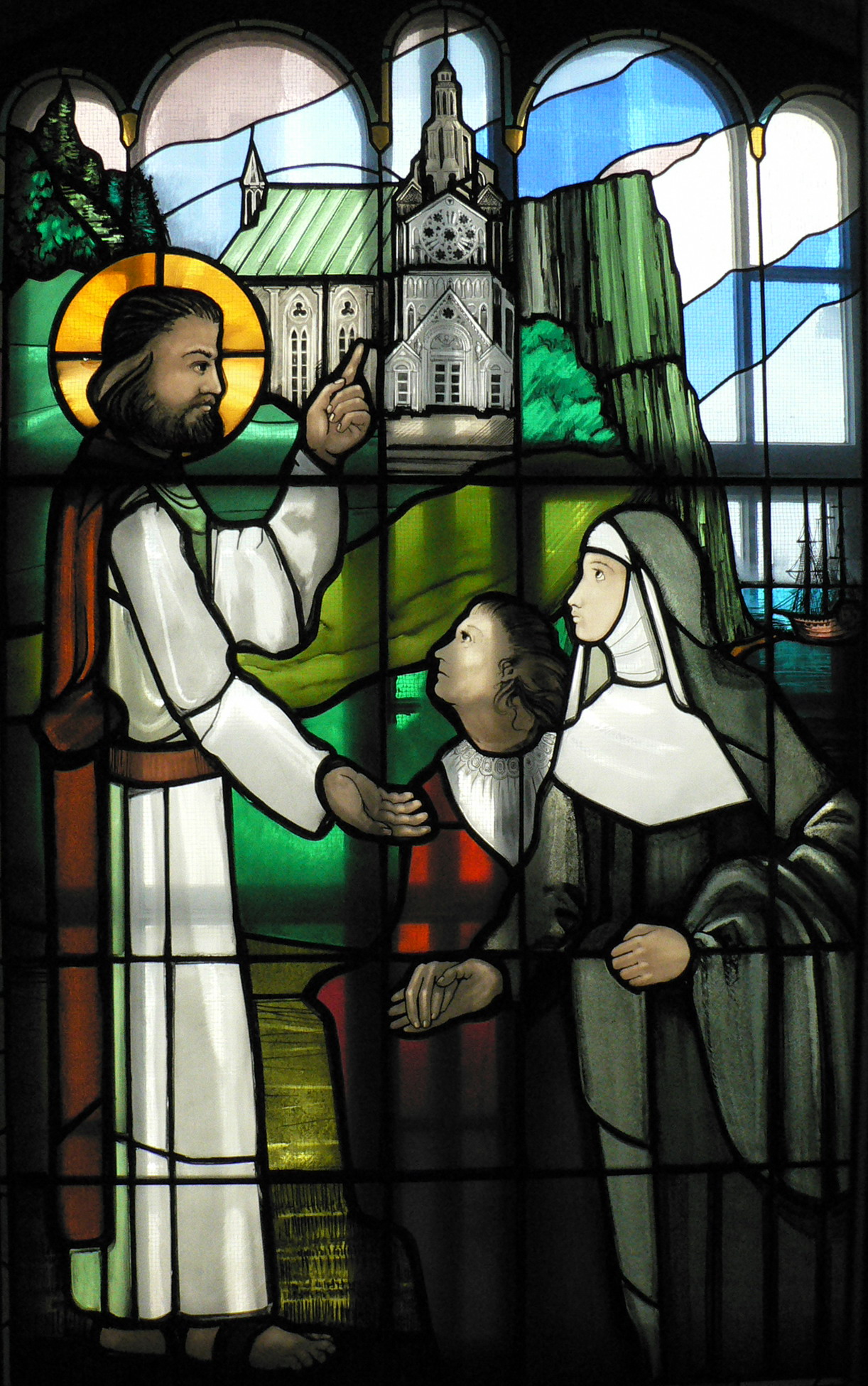
Shortly afterwards, she received a grace which would give lasting direction to the rest of her life:
- Between the age of 34 and 35 years, I entered into the state which had been revealed to me and for which I was waiting. It was the emanation of the apostolic spirit which was none other than the spirit of Jesus Christ, who took possession of my spirit so that there would be no life save in his and through his. My life was wholly in the interests of this divine and adorable Master and in zeal for his glory, so that he might be known, loved and adored by all the nations he had redeemed with his precious Blood. My body was in our monastery, but my spirit, united to that of Jesus, could not be shut up there. This apostolic spirit carried me in thought to the Indies, to Japan, to America, to the East and to the West, to the regions of Canada and among the Hurons - in short, to every part of the inhabited world where there were rational souls whom I saw as all belonging by right to Jesus Christ. I saw, with interior certainty, the demons gaining victory over these poor souls whom they snatched from the domain of Jesus Christ (...) As I saw this truly happening in front of me, I became jealous, I could no more endure the sight, I embraced all these poor souls and, holding them to my bosom, I presented them to the Eternal Father, telling him that it was time that he exercised his justice in favour of my Spouse(...)" "In spirit I roamed through these vast stretches and kept company with those labouring to spread the gospel there, to whom I felt closely united, because it seemed to me that I was one with them in spirit. Although in the body I was bound by my rules, in my spirit I never ceased travelling, nor did my heart cease its solicitation of love, swifter than any word, to the Eternal Father for the salvation of so many millions of souls.
(V, 300-301; J II, 309-313 Sullivan p.95)
Appointed assistant to the novice mistress in January 1634, Marie prepared them for their future task as catechists, while communicating to them her own burning missionary zeal. She spoke about the missions to the sisters, the pupils and to anyone who visited her in the parlour. She continued to pray; she wore herself out with her entreaties. She did not know yet that her prayer was imperfect...
- One night when I was representing to him this important affair, I realized interiorly that his Divine Majesty was not listening to me (...) This caused me great anguish (...) I threw myself at his feet, I humbled myself to the very depths of my being so that his divine Goodness might place in my soul whatever it was he wanted in order that my pleadings for the cause of my Spouse might be successful. Then I felt a ray of divine light, and at the same time I heard these words: "Ask of me by the Heart of Jesus, my dearly beloved Son; it is through him that I will hear you and grant your prayer.
(V, 305-306; 314-315 Sullivan p.98)
Marie would never forget this divine lesson. Henceforth, it was always "through the Heart of Jesus Christ" that she would ask the Eternal Father for the salvation of souls. A little later, she experienced the seizure of her will by God. Hereafter, it would be Christ praying in her, carrying out his will through her.
Moreover, the meaning of her dream in 1633 became clear: early in 1635, when Marie de 1'Incarnation was praying before the Blessed Sacrament, the vision of the mysterious country reappeared before her eyes, accompanied by an explanation and an order: "It is Canada that I have shown you; you must go there and make a home for Jesus and Mary".
Now she knew. But what was she to do? The Jesuit to whom she spoke put her off, so for the moment, Marie did nothing. This was God's affair, not hers; so she waited patiently, her own will lost in the divine will. To do nothing... to wait in peace... in a manner of speaking only, because she wrote at length to try and interest those in a position to help her; she fanned the zeal of the boarders of whom she had just been given charge, that of the novices and the religious of the community. And she waited... She would have to wait four years because there were numerous obstacles; there were also reservations on the part of those round her. She had no doubts herself. And, in fact, in its own good time, Providence intervened - in a most unexpected way.
EN ROUTE FOR CANADA
Madame de la Peltrie, née Madeleine de Chauvigny, was a young widow of Alençon who had decided to devote her fortune to a foundation in Canada. To realize this plan, she had to resort to romantic subterfuges, pretend that she was going to remarry, look for support in high places, obtain numerous authorizations, do battle every inch of the way with religious superiors and ecclesiastics. And so it was that one day she turned up at the door of the monastery of Tours. In the parlour, Marie de 1'Incarnation was stupefied: she recognized in Madame de la Peltrie the lady of her dream. From then onwards, everything fell into place so quickly; the departure would take place in a few days' time...days of suffering:- I had a vision of what would happen to me in Canada. I saw crosses without end, a crucifying interior abandonment on the part of God and of creatures; that I was about to enter on a hidden and unknown life. It seemed to me that the Majesty of God was saying to me with great insistence: “Go, you must now serve me at your own expense”(...) I cannot describe the fright this vision gave to the depth of my soul and nature (...) I felt like someone all alone and that I was already experiencing the terrible solitude of spirit which I would have to suffer in God's plan for me.
(V, 367; J II, 348-349 Sullivan p.117)
And, certainly, Marie suffered at the thought of her 20 year-old son whom she would never see again and whom, deliberately, she had not forewarned.
On 22 February 1639, Marie de 1'Incarnation, accompanied by a young sister of 22 years, Marie de Saint-Joseph, left her monastery for ever.
She had no inkling of the shock that awaited her at Orleans: Claude, warned by aunt Buisson, stopped his mother and tried to prevent her from leaving. What words was she not to wrench from her heart to calm him! She succeeded, though, in quietening him and the young man gave his consent. As for her, "it seemed as if my very bones were breaking", she was to say later.
In Paris, Madame de la Peltrie would try in vain to obtain an Ursuline from Paris for the foundation, because of the opposition from the Archbishop. The Queen, Anne of Austria, however, and other important persons from the Court and the capital showed interest in the adventure and promised help and protection. The convents also promised prayers and sacrifices.
At Dieppe, the little group was joined by Mère Cécile de Sainte-Croix, from the Congregation of Paris, and three nursing Augustinian sisters who were leaving to found a Hotel-Dieu, thanks to the Duchess of Aiguillon.
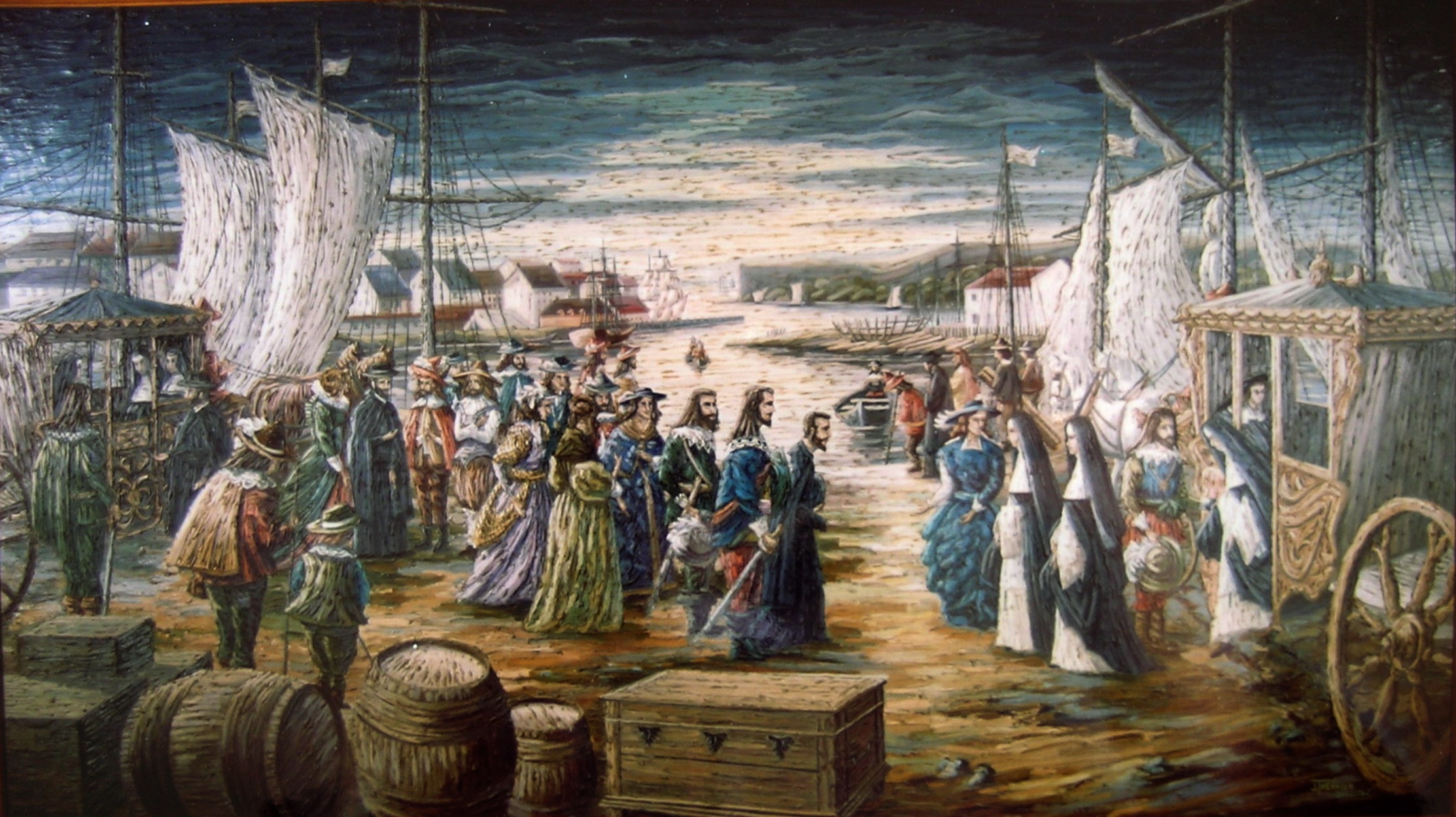
It was an epic journey lasting three months: sea sickness, storms, danger of an encounter with the Spaniards, treachery of fogs and, above all, terror caused by an iceberg, only just avoided - frightening everyone with the exception of Marie "totally absorbed in God's will".
IN NEW FRANCE
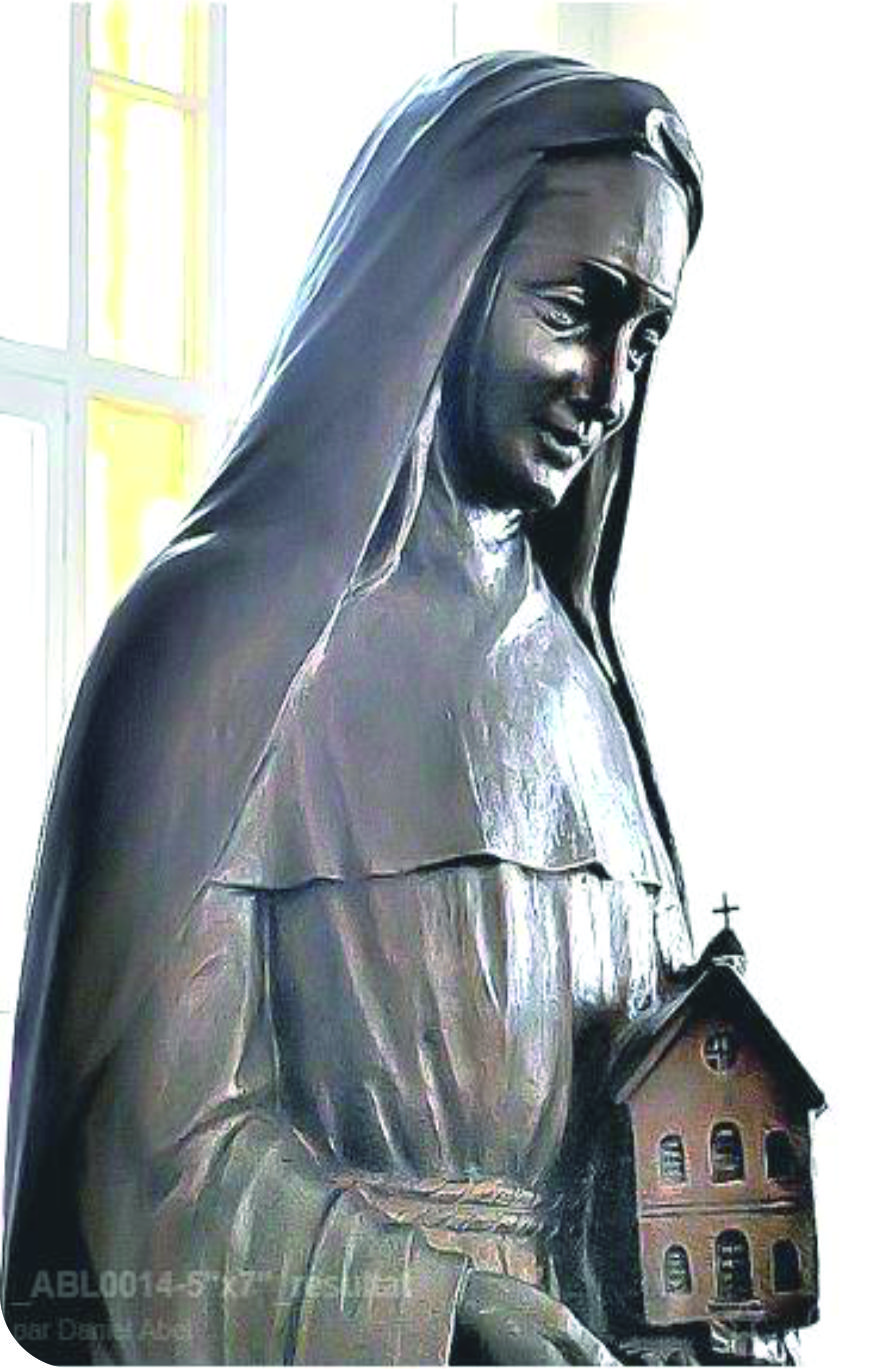 It was not until 1st August 1639 that the missionaries finally reached Quebec. Champlain had laid the foundations of this town in 1633. But at the time of Marie's arrival, there was hardly anything except the fortress (not a very imposing one, to tell the truth), a few stone houses and some log cabins; a small French colony of about 250 persons. There was a little settlement of Algonquins at Sillery, about a league from Quebec. The other Indian tribes were nomads. The Iroquois tribe was, and would remain for a long time, the terror of the colony.
It was not until 1st August 1639 that the missionaries finally reached Quebec. Champlain had laid the foundations of this town in 1633. But at the time of Marie's arrival, there was hardly anything except the fortress (not a very imposing one, to tell the truth), a few stone houses and some log cabins; a small French colony of about 250 persons. There was a little settlement of Algonquins at Sillery, about a league from Quebec. The other Indian tribes were nomads. The Iroquois tribe was, and would remain for a long time, the terror of the colony.There was an enthusiastic welcome from the Governor and the colonists, without mentioning that of the Jesuits, but the living conditions were deplorable: two small rooms, with no protection from the rain or wind, served for everything; a very severe climate; strange food; frequent threat of famine; fear, often justified, of war; adaptation to the dirtiness of the little Indians, their smell, their disconcerting psychology; the difficult learning of native languages... But what joy, too, when a young "savage" woman was converted and received baptism: "I had her given the name of our first mother, Saint Angela, thinking that this was fitting for her since God had converted her in a house of her daughters" (0, 165).
Marie de l'Incarnation would never cease "committing her whole life to the service of God and the poor savages". Work and a never-ending stream of troubles formed her daily lot, while her mystical life became ever deeper and simplified.
WORK AND TROUBLES
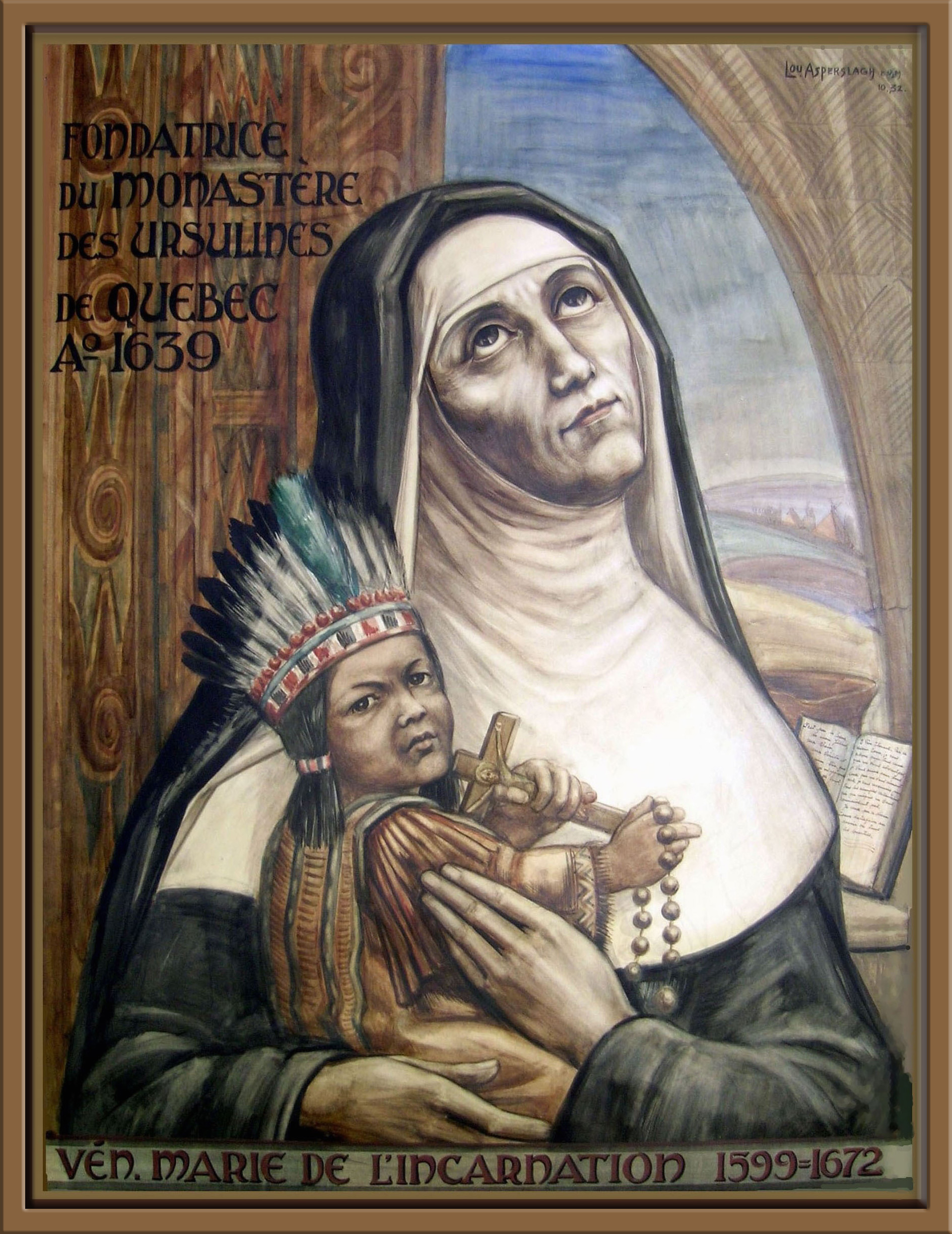 In order to teach the catechism to the Indian girls and women, Marie learnt the Montagnais, Algonquin and Huron languages. She started to learn Iroquois when she was nearly 70 years old. She gave lessons to her young sisters; and, to help her pupils and the religious who would come after her, she composed dictionaries, grammar and catechism books in these "barbaric" languages.
In order to teach the catechism to the Indian girls and women, Marie learnt the Montagnais, Algonquin and Huron languages. She started to learn Iroquois when she was nearly 70 years old. She gave lessons to her young sisters; and, to help her pupils and the religious who would come after her, she composed dictionaries, grammar and catechism books in these "barbaric" languages.She admitted young French girls of the colony to her classes, not easy young ladies it would seem, since thirty of them were more of a handful than sixty in France! Her parlour was never empty: religious, inhabitants of Quebec, beginning with the authorities, visitors from France, travellers just passing through who came to ask for prayers or to seek advice; Marie's influence on the colony's development was considerable.
And then she wrote. She kept up a frequent and continuous correspondence with her son, with the Jesuit missionaries in Canada itself, with her sisters in Tours and numerous convents in France, with her own family. She wrote to those important people whose acquaintance she had made in Paris and who had promised help and protection; she knew how to thank them, to keep them informed as to what was happening, how to keep alive their interest and also how to reach out to them. Her letters were often colourful, written in haste and in conditions of complete discomfort.
There was certainly no dearth of work.
Nor was there any shortage of troubles. For one who was to spend all her time being either superior or bursar, in other words responsible for all the material side of the convent, the experience gained by the events of her earlier life proved invaluable:
- I see and experience that all the conditions, trials, work and indeed all that happened to me in my brother's (in law) house, was a way of training me for Canada; it was a kind of novitiate for me, from which I did not emerge perfect, but nevertheless able, by God's grace, to carry the troubles and work in Canada.
(V, 56; J II, 85)
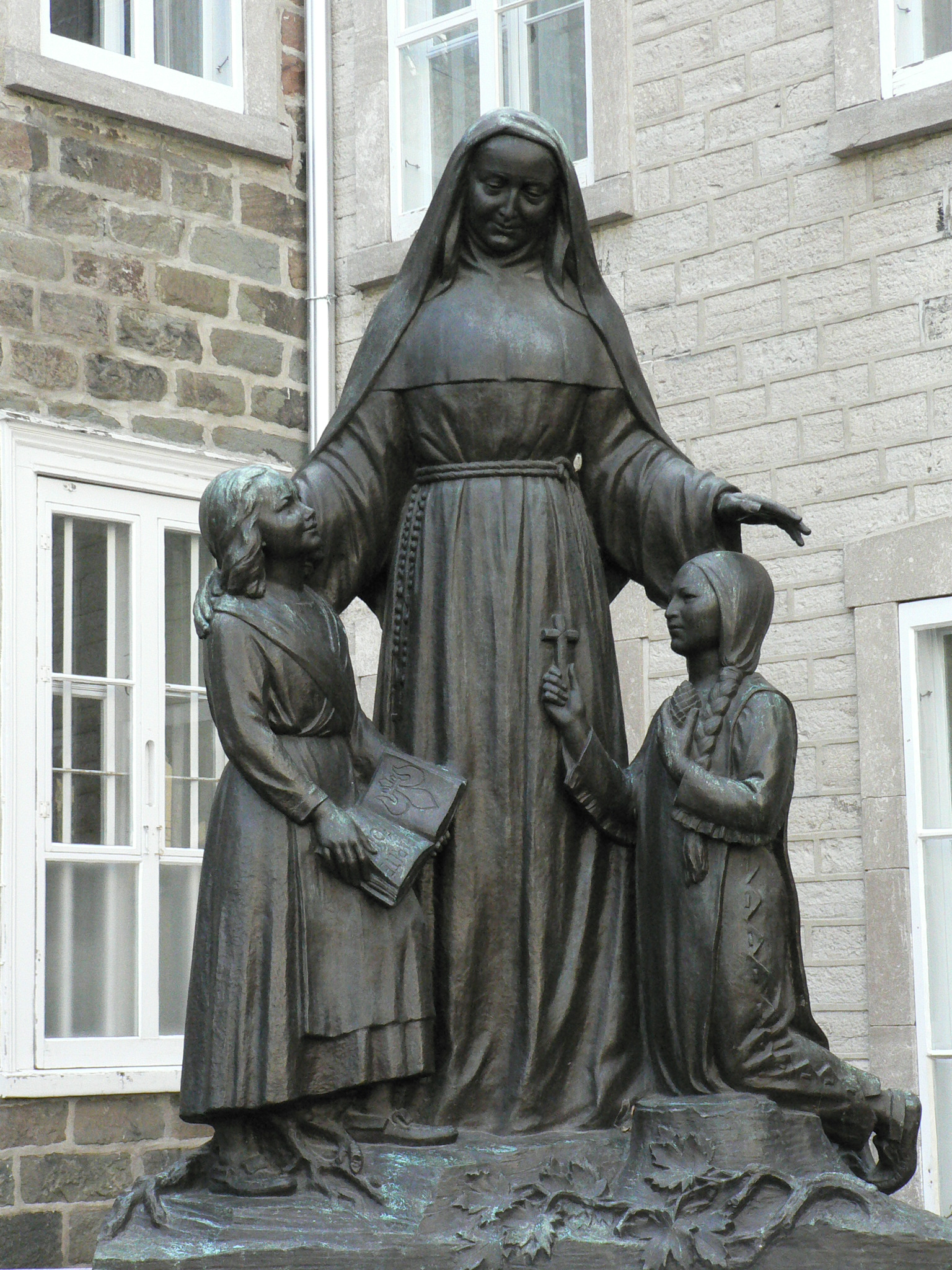 There was the problem of the Constitutions: two sisters from Paris had come to join the little group in 1640. But "Paris" and "Tours" did not have the same Constitutions, so an adaptation was necessary, especially as certain customs, normal in France, were completely unsuitable in Canada.
There was the problem of the Constitutions: two sisters from Paris had come to join the little group in 1640. But "Paris" and "Tours" did not have the same Constitutions, so an adaptation was necessary, especially as certain customs, normal in France, were completely unsuitable in Canada.There were the ever-present financial worries which became even more acute in 1641 after the departure of Madame de la Peltrie to Montreal - a sudden whim which seized her and which she was to regret; she returned to Quebec at the end of 1643, or the beginning of 1644.
There was the building of the monastery - everything had to be ordered from France, materials and workmen, without counting a good deal of the food. Then this poor building was engulfed in flames at Christmas 1650, and so there were all the problems involved with getting it reconstructed.
There was also the war, raids by the Iroquois (1646-1649), and the martyrdom of several Jesuit Fathers.
There were clashes with the first bishop of New France on the subject of the community rules. Within the community, there were sufferings of another kind; two sisters returned to France.
There were earth tremors (1663); Marie was deeply worried by the ravages produced among the tribes by the brandy, and there were her interventions with the Governor (0, 681).
And there was the mother's constant anxiety about the son she had left behind, this son who had found it so difficult to know what path to take, but who had ended by entering with the Benedictines in 1641. Claude, however, had not inherited the natural optimism of his mother and she had to support him constantly by her affection and letters. Thanks to his mother's direction and advice, both deeply spiritual and realistic, Claude would become a holy monk. It was in reply to his repeated request that Marie wrote, in 1654, a second Relation of her spiritual life. She also gave helpful advice to her niece, Marie Buisson, who herself entered with the Ursulines of Tours in 1644 and took the same name as her aunt in religious life.
MYSTICAL LIFE
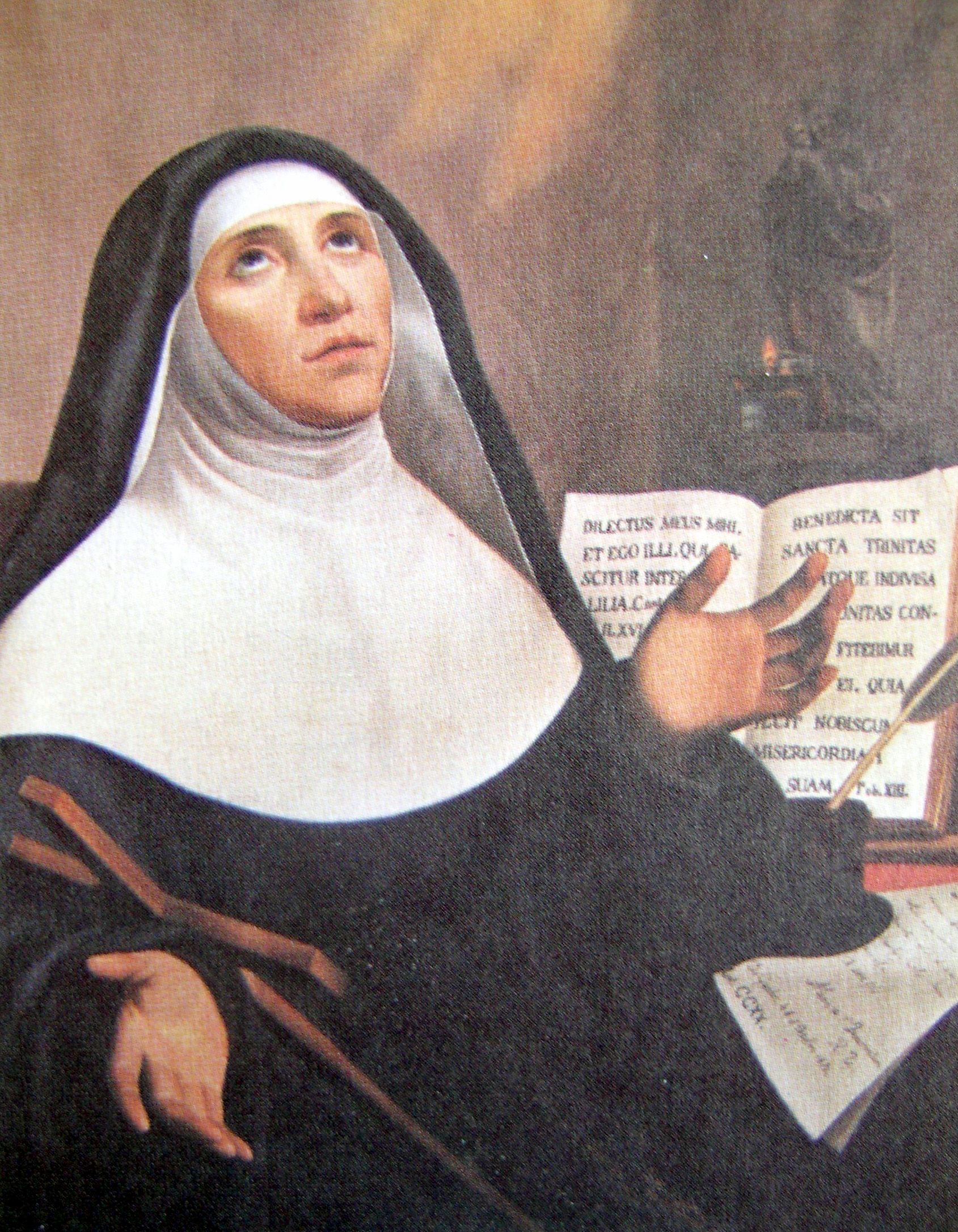 In the "Relation of 1654", Marie explained how, after her arrival in Canada, she had had to suffer a long night lasting seven years during which everything was a cross for her. Marie was plunged as it were in hell; she experienced an extreme aversion for her sisters; she was familiar with the temptations of despair. She was helped in this trial by Père Jerome Lalemant, Jesuit, who allowed her, in 1645, to make a vow to seek the greater glory of God in everything.
In the "Relation of 1654", Marie explained how, after her arrival in Canada, she had had to suffer a long night lasting seven years during which everything was a cross for her. Marie was plunged as it were in hell; she experienced an extreme aversion for her sisters; she was familiar with the temptations of despair. She was helped in this trial by Père Jerome Lalemant, Jesuit, who allowed her, in 1645, to make a vow to seek the greater glory of God in everything.Père Lalemant also helped her to draw up the Constitutions of the Canadian monastery. These were finished in 1647. And, this same year, light returned once more to Marie's soul, quite suddenly, on the feast of the Assumption. In 1650, she was able to welcome the fire at the convent with words of blessing and abandonment. In 1653, when it seemed that Canada would be lost, she made a vow to be a victim "for this unfortunate country." Resisting the pressures that came from France for the Ursulines to leave Canada, Marie de 1'Incarnation, fortified by interior assurance, continued to rebuild - in the company of the Blessed Virgin Mary:
- I had no sooner begun when I felt her assistance in an extraordinary way and manner. She was constantly present to me. I did not actually see her with my eyes or in an imaginary vision, but in the same way that the adorable Word Incarnate had shown me the honour and mercy of communicating himself to me, by union, love and continual and actual communication, which I had never experienced, except for this occasion, with regard to the Virgin Mother of God, even though I have always had a great devotion to her. But now, in addition to my interior union with her which made me speak to her from the depth of my soul through my very simple and intense loving activity, as to her beloved Son, I felt her near me without seeing her, accompanying me everywhere in all my comings and goings which I was obliged to undertake in the building from the time of the demolition work until the rebuilding had been completed. As I went on my way, I used to converse with her, saying to her: “Come along, my divine Mother, let us go and see our workmen". According to the circumstances, I used to go up and down the scaffolding, without any fear, talking to her in this way...
(V, 588-589; J II, 440-441 Sullivan p.168)
As for her interior life, it became more and more simple and detached from self. Let us listen to what she wrote in two of her last letters to Claude:
- October 1668. I no longer use words at the feet of the divine Majesty. My prayers consist only of the words: My God, my God, be blessed, O my God. This is the way my days and nights pass, and I hope that his Goodness will let me die with these words on my lips, and that he will let me die as he has let me live. I have said “with these words”; it would be better if I said “with these sighs”, which do not allow me to make any act; and I do not know how to put into words when it comes to expressing things as bare and simple as these, which consume my soul in its sovereign and unique good, in its simple and unique totality.
(V, 713; 0, 826) - Two years later. I see myself in a state of being lost in his divine Majesty who, for several years, has held me in an exchange, in a relationship, in a union and privacy which I cannot explain. It is a kind of poverty of spirit which does not allow me to converse with the Angels either about the delights of the Blessed, or about the mysteries of faith. Sometimes I have an inner longing to distract myself by staying there with them and enjoying myself in their beauty as in things I am very fond of; but immediately I forget them; and the Spirit who leads me, brings me back to an ever deeper intimacy and depth where I am lost in the One who pleases me more than anything (...) In these depths the soul holds immense treasures without limit: there is nothing material, but a totally pure and naked faith which speaks of eternal things.
(V, 717; 0, 896-897)
TOWARDS CONSUMMATED UNION
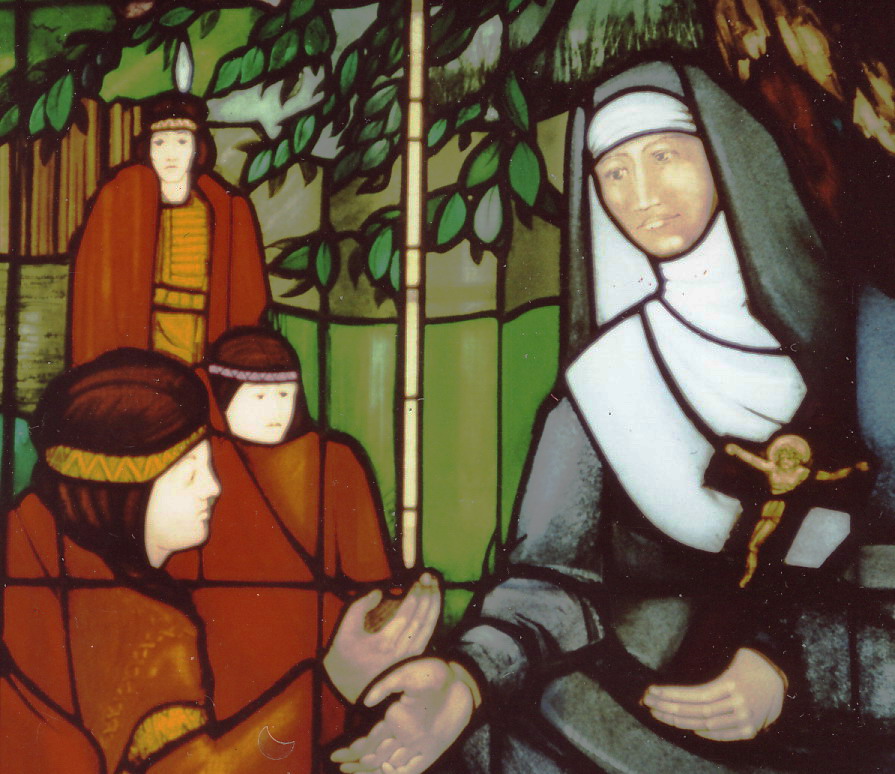 When Marie wrote these lines, she was 70; she had two more years to spend on earth. She had always had a strong constitution but, in 1645, she had been very ill, and again in 1657, this time more seriously. She had recovered. Since 1664, though, she was the prey of almost continual sufferings for which she had been prepared by a prophetic dream - yet another! She had continued to work as usual. In 1671 she had seen Madame de la Peltrie die, then she herself had fallen seriously ill and had to consent to go to bed on Good Friday 1672. Knowing that her end was near, she allowed her dear little “savages” to enter her room; she smiled at them and gave them a last blessing. On 30 April 1672, holding her crucifix close to her heart, she at last entered into the joy of her "great God."
When Marie wrote these lines, she was 70; she had two more years to spend on earth. She had always had a strong constitution but, in 1645, she had been very ill, and again in 1657, this time more seriously. She had recovered. Since 1664, though, she was the prey of almost continual sufferings for which she had been prepared by a prophetic dream - yet another! She had continued to work as usual. In 1671 she had seen Madame de la Peltrie die, then she herself had fallen seriously ill and had to consent to go to bed on Good Friday 1672. Knowing that her end was near, she allowed her dear little “savages” to enter her room; she smiled at them and gave them a last blessing. On 30 April 1672, holding her crucifix close to her heart, she at last entered into the joy of her "great God."Her life was a magnificent illustration of Angela's encouraging words:
- "Act, move, believe, strive, hope, cry out to him with all your heart; for without doubt, you will see marvellous things" (Pr. Counsels).
And Saint Angela, in her Rule, had recommended to her daughters a prayer filled with apostolic spirit:
- "Deign also to forgive the sins (...) of the whole world. I implore this of you by your most sacred Passion and your precious Blood shed for love of us (...) Lord, in place of those poor creatures who do not know you, and do not care to be partakers in your most sacred Passion, my heart breaks, and willingly (if I could) I would shed my own blood to open the blind eyes of their minds" (R. V).
And Marie de l'Incarnation, as an echo of this prayer, used to present the following daily prayer to the Eternal Father:
- It is through the Heart of Jesus, my way, my truth and my life, that I approach you, Eternal Father. Through this divine Heart, I adore you for all those who do not adore you; I love you for all those who do not love you; I praise you for all the willfully blind who, out of contempt, do not recognize you. Through this divine Heart, I want to give the satisfaction which should be the duty of all. In spirit, I go round the world in search of all the souls redeemed by the precious Blood of my divine Spouse. Through this divine Heart, I want to make satisfaction for all. I embrace them in order to present them to you through him, and through him I beg for their conversion. Can it be, Eternal Father, that you will allow them to remain in ignorance of my Jesus? Is it your will that they do not live in the One who died for all? You can see, 0 heavenly Father, that they are not yet alive. Oh! give them life through this divine Heart.
On this adorable Heart as on a divine altar, I present to you all who labour for the Gospel so that through the merits of this divine Heart they may be filled with your Spirit.
You know, 0 my Beloved, all that I want to say to your Father through your divine Heart. Whatever I address to you I address to the Father, because you are in your Father and your Father is in you. I present to you all these souls, including my own; make us all one with you.
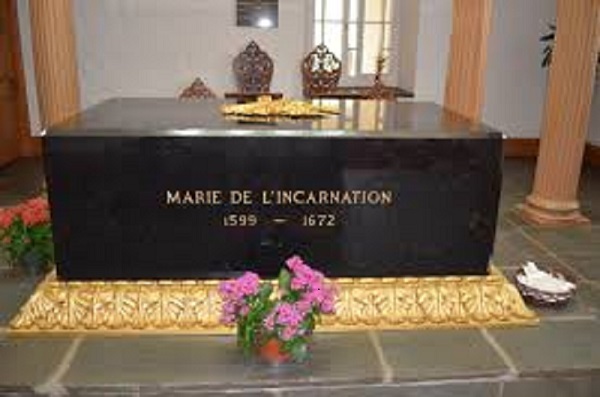
The French Ursuline of the 17th century was the true daughter of Angela. Marie de l'Incarnation was beatified on 22 June 1980.
